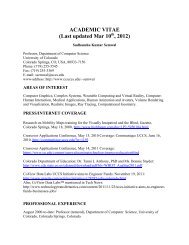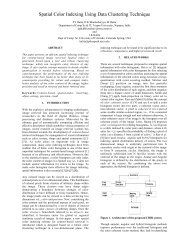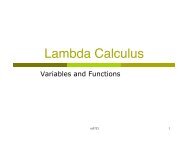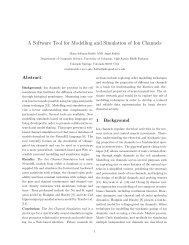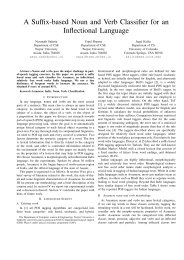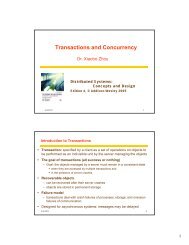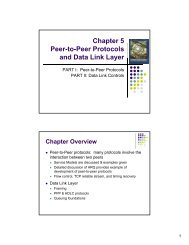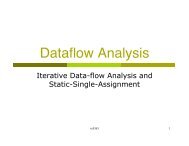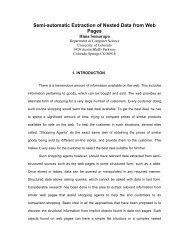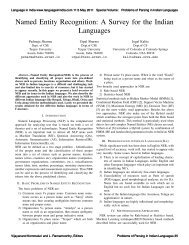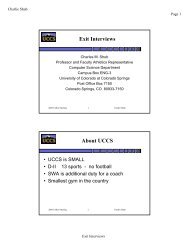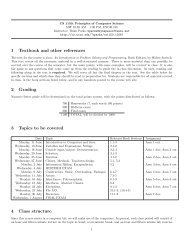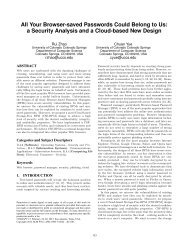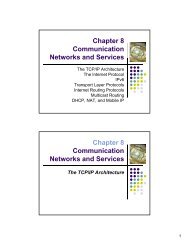Similarity Templates or Schemata
Similarity Templates or Schemata
Similarity Templates or Schemata
You also want an ePaper? Increase the reach of your titles
YUMPU automatically turns print PDFs into web optimized ePapers that Google loves.
<strong>Similarity</strong> <strong>Templates</strong> <strong>or</strong> <strong>Schemata</strong><br />
CS 571<br />
Evolutionary Computation
Similarities among Strings in a Population<br />
• A GA has a population of strings (solutions) that<br />
change from generation to generation.<br />
• What inf<strong>or</strong>mation is contained in a population of<br />
strings How do we characterize the inf<strong>or</strong>mation<br />
content in GA’s generation<br />
• How does understanding of the inf<strong>or</strong>mation contained<br />
in a population of strings help us understand<br />
the way genetic alg<strong>or</strong>ithms move in a directed manner<br />
toward betters strings (solutions)<br />
1
Example<br />
• Assume we have a population of 4 strings with the<br />
String Fitness<br />
01101 169<br />
following fitness values: 11000 576<br />
01000 64<br />
10011 361<br />
• What inf<strong>or</strong>mation is contained in this population to<br />
guide a directed search f<strong>or</strong> improvement<br />
• Notice the similarities in the strings and their c<strong>or</strong>responding<br />
fitness values<br />
• We notice that certain string patterns seem to be<br />
associated with high fitness values.<br />
• In particular, string values that start with 1 seem<br />
to have high fitness values.<br />
2
What are we seeking to understand<br />
• We want to highlight similarities among strings in<br />
a population.<br />
• We are then looking f<strong>or</strong> causal relationships between<br />
these similarities and high fitness.<br />
• This provides us with a wealth of inf<strong>or</strong>mation that<br />
can help guide a search.<br />
3
<strong>Schemata</strong> <strong>or</strong> <strong>Similarity</strong> <strong>Templates</strong><br />
• We are interested in understanding how imp<strong>or</strong>tant<br />
similarities among highly fit strings can help guide<br />
search.<br />
• Question: How is a string similar to another string<br />
• Question: How does a string represent a set of<br />
string classes such that these string classes have<br />
similarities in certain string positions<br />
4
<strong>Schemata</strong><br />
• A schema is a template that describes a subset of<br />
strings with similarities at certain string positions.<br />
• Alphabet needed to describe a schema f<strong>or</strong> binary<br />
strings: {0, 1, ∗} where ∗ is don’t care.<br />
• A schema matches a particular string if at every location<br />
in the schema, a 1 matches a 1 in the string,<br />
a 0 matches a 0 in the string, and a * matches<br />
either 0 <strong>or</strong> 1 in the string.<br />
5
<strong>Schemata</strong> Examples<br />
• The schema *0000 matches the set of strings 10000,<br />
00000.<br />
• The schema *111* matches the set of strings 01110,<br />
01111, 11110, 11111.<br />
• The schema 0*1** matches the set of 8 strings of<br />
length 5 that begin with a 0 and have a 1 in the<br />
3rd bit position.<br />
• A schema gives us a way to talk about well-defined<br />
similarities among finite-length strings over a finite<br />
alphabet.<br />
• Remember, although we use the * symbol, * is<br />
never explicitly processed by a genetic alg<strong>or</strong>ithm.<br />
6
Counting <strong>Schemata</strong><br />
• if length of the schema=l=5, we have 3 × 3 × 3 ×<br />
3 × 3 = 243 different similarity templates because<br />
each of the five positions may be a 0 <strong>or</strong> 1 <strong>or</strong> *.<br />
• In general, f<strong>or</strong> an alphabet of cardinality k, there<br />
are (k + 1) l schemata.<br />
7
Counting <strong>Schemata</strong><br />
• How much inf<strong>or</strong>mation is there in a population at<br />
any time during a genetic alg<strong>or</strong>ithm’s execution<br />
• Related question: How many unique schemata are<br />
there in a population<br />
• First: Count how many schemata are there in a<br />
single string of 0s and 1s.<br />
• A particular string of length l has 2 l schemata.<br />
• Example: Consider a single string of length 5: 11111.<br />
There are 2 5 schemata in it because each position<br />
may take its actual value <strong>or</strong> the don’t care value *.<br />
• Next:How many schemata are there in a population<br />
of n: Between 2 l and n × 2 l depending on population<br />
diversity.<br />
8
How many schemata are processed by a genetic<br />
alg<strong>or</strong>ithm<br />
• Of the 2 l to n × 2 l schemata in a population, how<br />
many are processed in a useful manner by a genetic<br />
alg<strong>or</strong>ithm<br />
• To obtain the answer, we have to consider the effect<br />
of reproduction, crossover and mutation on the<br />
growth <strong>or</strong> decay of imp<strong>or</strong>tant/useful schemata from<br />
generation to generation.<br />
• Genetic alg<strong>or</strong>ithms exploit in parallel the many similarities<br />
contained in high perf<strong>or</strong>mance schemata.<br />
• Explicit processing of strings really causes the implicit<br />
processing of many schemata during each generation.<br />
9
Schema Properties: Order and Length<br />
• Certain schemata are m<strong>or</strong>e general (specific) than<br />
others.<br />
• F<strong>or</strong> example, the schema 011*1** is m<strong>or</strong>e specific<br />
than the schema 0******.<br />
• Certain schemata span m<strong>or</strong>e of the total string than<br />
others.<br />
• F<strong>or</strong> example, the schema 1****1* spans a larger<br />
p<strong>or</strong>tion of the string than he schema 1*1****.<br />
• To quantify these, we define two schema properties:<br />
schema <strong>or</strong>der and schema length.<br />
10
Schema Properties: Order and Length<br />
(continued)<br />
• Schema Order: The <strong>or</strong>der of a schema H, denoted<br />
by o(H) is the number of fixed positions present in<br />
the template.<br />
• F<strong>or</strong> example, o(011∗1∗∗) = 4 and o(0∗∗∗∗∗∗) = 1.<br />
• Schema Length: The length of a schema, denoted<br />
by δ(H) is the distance between the first and the<br />
last specific string position.<br />
• F<strong>or</strong> example, δ(011 ∗ 1 ∗∗) = 4 and δ(0 ∗ ∗ ∗ ∗ ∗ ∗) = 0<br />
11
Effect of Reproduction Alone<br />
• Suppose at time step t, there are m examples of<br />
a particular schema H contained within population<br />
A(t). Let us call this m = m(H, t)<br />
• During reproduction, a string A i is copied acc<strong>or</strong>ding<br />
to its fitness f i .<br />
• In other w<strong>or</strong>ds, string A i gets selected f<strong>or</strong> reproduction<br />
with probability p i =<br />
f i<br />
Σ n j f j .<br />
• Let m(H, t + 1) be the number of representatives of<br />
schema H in the population at time t + 1 if we use<br />
reproduction only.<br />
• We can write<br />
m(H, t + 1) = m(H, t) × n × f(H)<br />
Σ n j f j<br />
12<br />
(1)
Effect of Reproduction Alone (continued)<br />
• The average fitness of the entire population is<br />
¯f = Σn j f j<br />
n<br />
• Then, we can write Equation (1) as:<br />
m(H, t + 1) = m(H, t) × f(H)<br />
¯f<br />
(2)<br />
(3)<br />
• Equation (3) is called the Schema Difference Equation<br />
13
Effect of Reproduction Alone: Conclusions<br />
• A particular schema grows in prop<strong>or</strong>tion to the ratio<br />
of the average fitness of the schema to the average<br />
fitness of the population.<br />
• <strong>Schemata</strong> with fitness values above the population<br />
average will have m<strong>or</strong>e samples in the next generation,<br />
while schemata with fitness values below<br />
the population will have fewer samples in the next<br />
generation.<br />
• This expected behavi<strong>or</strong> is carried out with every<br />
schema H contained in a particular population A in<br />
parallel.<br />
• In other w<strong>or</strong>ds, all the schemata in a population<br />
grow <strong>or</strong> decay acc<strong>or</strong>ding to their schema averages<br />
under the operation of reproduction alone.<br />
14
Ref<strong>or</strong>mulating the Schema Difference Equation<br />
• It is clear that above-average schemata grow and<br />
below-average schemata die off.<br />
• Consider above-average schemata only.<br />
• Suppose that a particular schema H remains above<br />
average in each generation by an amount c ¯f where<br />
c is a constant.<br />
• Now, we can rewrite the Schema Difference Equation<br />
as<br />
m(H, t + 1) = m(H, t) × f(H)<br />
¯f<br />
= m(H, t) × ¯f + c ¯f<br />
¯f<br />
= (1 + c) × m(H, t)<br />
15<br />
(4)
Ref<strong>or</strong>mulating the Schema Difference Equation<br />
(Continued)<br />
• Equation (4) is a recurrence relation.<br />
• Thus, f<strong>or</strong> above-average schemata, we can write<br />
the following if we start at time t = 0:<br />
m(H, t) = m(H, t − 1) × (1 + c) (5)<br />
= m(H, t − 2) × (1 + c) 2<br />
.<br />
= m(H, 0) × (1 + c) t 16
Ref<strong>or</strong>mulating the Schema Difference Equation<br />
(Continued)<br />
• In general,<br />
m(H, t) =m(H, 0) ×<br />
{ } t f(H)<br />
(6)<br />
¯f<br />
• Thus, m(H, t) is exponential in t.<br />
• If f<strong>or</strong> a certain schema,<br />
{<br />
f(H)<br />
¯f<br />
}<br />
> 1 consistently<br />
from generation to generation, we call it an aboveaverage<br />
schema.<br />
If<br />
{<br />
f(H)<br />
¯f<br />
}<br />
< 1 consistently f<strong>or</strong> a<br />
certain schema, it is a below-average schema.<br />
• Effect of Reproduction: Reproduction produces exponentially<br />
increasing (decreasing) number of samples<br />
to above- (below-) average schemata.<br />
17
Effect of Reproduction (continued)<br />
• In the above, we assumed that we only have a reproduction<br />
operation, and no other operations.<br />
• In effect, we assumed that we choose high fitness<br />
members of the population and reproduce (exact<br />
copy) them into the next generation.<br />
• Thus, it is surprising to learn that reproduction<br />
can allocate exponentially increasing and decreasing<br />
number of schemata to future generations in<br />
parallel.<br />
• However, reproduction alone does not promote expl<strong>or</strong>ation<br />
since no new points are searched: If we<br />
only copy old structures without change, we don’t<br />
try anything new at all.<br />
• This is where crossover steps in.<br />
18
Introducing Crossover<br />
• Crossover is a structured yet randomized inf<strong>or</strong>mation<br />
exchange between strings.<br />
• Crossover creates new structures, and we will see<br />
that it does so with a minimum of disruption to the<br />
allocation strategy dictated by reproduction alone.<br />
• Thus, use of reproduction with crossover results<br />
in exponentially increasing (<strong>or</strong> decreasing) prop<strong>or</strong>tions<br />
of schemata in a population in many of the<br />
schemata contained in the population.<br />
19
Effect of Crossover<br />
• Some schema are affected by crossover and others<br />
are not.<br />
• Consider a particular string of length 7 and two<br />
representative schemata.<br />
A = 0 1 1 1 0 0 0<br />
H 1 = * 1 * * * * 0<br />
H 2 = * * * 1 0 * *<br />
• Clearly both schemata H 1 and H 2 are represented<br />
in the string A.<br />
• In simple crossover, we randomly choose a mate,<br />
and then randomly choose a crossover point.<br />
20
Effect of Crossover (Continued)<br />
• Assume A participates in crossover and the crossover<br />
point is between third and fourth bits.<br />
• Consider the effect of this specific crossover on the<br />
two schemata that can be used to represent A.<br />
A = 0 1 1 | 1 0 0 0<br />
H 1 = * 1 * | * * * 0<br />
H 2 = * * * | 1 0 * *<br />
• Unless string A ′ s mate is identical to A at the fixed<br />
positions of the schema, the schema H 1 will be destroyed<br />
because the 1 at position 2 and the 0 at<br />
position 7 will be placed in different offspring. They<br />
are on opposite sides of the crossover point.<br />
21
Effect of Crossover (Continued)<br />
• With the same crossover point, schema H 2 will survive<br />
because 1 at position 4 and 0 at position 5 will<br />
go intact into an offspring.<br />
• In general, schema H 1 is less likely to survive crossover<br />
than schema H 2 because on average the crossover<br />
point is m<strong>or</strong>e likely to fall between the extreme fixed<br />
positions.<br />
• Quantifying the observation: Schema H 1 has a defining<br />
length of 5 and schema H 2 has a defining length<br />
of 1.<br />
• The schema length has a role to play in if a schema<br />
survives a crossover.<br />
22
Quantifying Effect of Crossover<br />
• Consider schema H 1 .<br />
• Quantifying the observation: If the crossover point<br />
is selected unif<strong>or</strong>mly at random among the l − 1=<br />
7 − 1 = 6 possible positions, we conclude that<br />
– schema H 1 is destroyed with probability<br />
p d = δ(H 1)<br />
l − 1 = 5 6<br />
– schema H 1 survives with probability<br />
p s =1− 5 6 = 1 6<br />
23
Quantifying Effect of Crossover (Continued)<br />
• A lower bound on crossover survival probability p s<br />
can be found f<strong>or</strong> any schema H.<br />
• A schema survives when the cross site falls outside<br />
the defining length. The schema is likely to be<br />
disrupted when a site within the defining length is<br />
chosen f<strong>or</strong> crossover. Theref<strong>or</strong>e,<br />
– the survival probability is<br />
p s =1− δ(H)<br />
l − 1<br />
if the crossover point is chosen unif<strong>or</strong>mly from<br />
among all possible choices.<br />
24
Quantifying Effect of Crossover (Continued)<br />
• If crossover is perf<strong>or</strong>med with a probability of p c in a<br />
particular mating, the survival probability becomes<br />
p s =1− p c × δ(H)<br />
l − 1<br />
(7)<br />
• The combined effect of reproduction and crossover<br />
can now be written out by considering the number<br />
of a particular schema H in hte next generation:<br />
m(H, t + 1) = m(H, t) × f(H)<br />
¯f<br />
×<br />
[<br />
1 − p c × δ(H)<br />
l − 1<br />
]<br />
(8)<br />
25
Summary: Effect of Crossover<br />
• In Equation (8), the combined effect of reproduction<br />
and crossover is obtained by multiplying the expected<br />
number of schemata f<strong>or</strong> reproduction alone<br />
by the survival probability under crossover p s<br />
• Schema H grows <strong>or</strong> decays depending on a multiplication<br />
fact<strong>or</strong>.<br />
• The multiplication fact<strong>or</strong> depends on two things:<br />
whether the schema has relatively long <strong>or</strong> sh<strong>or</strong>t<br />
defining length, and whether the schema is above<br />
<strong>or</strong> below the population average.<br />
26
Summary: Effect of Crossover (Continued)<br />
• We can write the<br />
m(H, t) =m(H, 0)×<br />
{<br />
f(H)<br />
¯f<br />
×<br />
[<br />
1 − p c × δ(H)<br />
l − 1<br />
]} t<br />
(9)<br />
• An above-average schema is one f<strong>or</strong> which f(H) > 1.<br />
¯f<br />
F<strong>or</strong> a below-average schema, this ratio is less than<br />
1.<br />
• Schema f<strong>or</strong> which × [ 1 − p c × δ(H) ] }<br />
l−1<br />
> 1, will<br />
{<br />
f(H)<br />
¯f<br />
increase in number in future generations.<br />
• The number of times a schema with both aboveaverage<br />
fitness and sh<strong>or</strong>t defining length occurs increases<br />
exponentially in future generations.<br />
27
Effect of Mutation<br />
• Mutation is the random alteration of a single position<br />
with probability p m .<br />
• F<strong>or</strong> a schema H to survive, all the specified positions<br />
must themselves survive.<br />
• Each single allele survives with a probability (1−p m )<br />
• The probability of surviving mutation is obtained by<br />
multiplying the survival probability o(H) times:<br />
(1 − p m ) o(H) ≈ 1 − o(H) × p m<br />
if p m is assumed to be small, i.e., p m
Effect of Mutation (Continued)<br />
• The total effect of reproduction, crossover and mutation<br />
is<br />
m(H, t+1) = m(H, t)× f(H) ×<br />
¯f<br />
• Once again, we can write<br />
{<br />
f(H)<br />
m(H, t) =m(H, 0)× ×<br />
¯f<br />
[<br />
[<br />
1 − p c × δ(H)<br />
l − 1 − o(H) × p m<br />
(10)<br />
1 − p c × δ(H)<br />
l − 1 − o(H) × p m<br />
(11)<br />
]<br />
]} t<br />
29
Effect of Mutation (Continued)<br />
• If f<strong>or</strong> a schema,<br />
{<br />
f(H)<br />
¯f<br />
× [ 1 − p c × δ(H)<br />
l−1 − o(H) × p ] }<br />
m ><br />
1 consistently from generation to generation, the<br />
number of times this schema occurs in the population<br />
increases exponentially from generation to<br />
generation.<br />
• This is the Schema The<strong>or</strong>em: The number of<br />
sh<strong>or</strong>t, low-<strong>or</strong>der, above-average schemata increases<br />
exponentially in future generations as<br />
a genetic alg<strong>or</strong>ithm progresses.<br />
30
How Many <strong>Schemata</strong> are Processed Usefully<br />
• Between 2 l and n × 2 l schemata are present in a<br />
population of n binary strings each of length l.<br />
• Not all of these are processed with high probability<br />
because crossover destroys those with relatively<br />
long defining lengths.<br />
• Acc<strong>or</strong>ding to Holland, θ(n 3 ) schemata are processed<br />
usefully by a genetic alg<strong>or</strong>ithm.<br />
• In other w<strong>or</strong>ds, although we explicitly process only<br />
n strings in each generation, a genetic alg<strong>or</strong>ithm<br />
processes n 3 schemata.<br />
• Holland calls it implicit parallelism. It is parallelism<br />
that is obtained without any special bookkeeping <strong>or</strong><br />
mem<strong>or</strong>y.<br />
31
The Building Block Hypothesis<br />
• We can understand the progress of a genetic alg<strong>or</strong>ithm<br />
as processing sh<strong>or</strong>t, low-<strong>or</strong>der, highly fit<br />
schemata to produce strings that are of potentially<br />
higher fitness.<br />
• This perspective reduces the complexity of our problem<br />
solving approach: Instead of building high-perf<strong>or</strong>mance<br />
strings by trying all possible combinations, we construct<br />
better and better strings from the best partial<br />
solutions in the population of strings.<br />
• Highly fit schemata of low <strong>or</strong>der and low length are<br />
called The Building Blocks of genetic alg<strong>or</strong>ithms.<br />
• Hypothesis: Building blocks combine to f<strong>or</strong>m better<br />
strings.<br />
32
The Building Block Hypothesis (Continued)<br />
• The Building Block Hypothesis is reasonable, but is<br />
it true<br />
• There is a lot of empirical evidence: We have examples<br />
of complex problems which have been solved<br />
by genetic alg<strong>or</strong>ithms in all kinds of domains.<br />
• But, where is the the<strong>or</strong>etical proof<br />
• The proof has been given by Bethke (1981) and<br />
Holland (1987) in terms of Walsh functions which<br />
are digital counterparts of sine and cosine functions.<br />
33
The Building Block Hypothesis (Continued)<br />
• Bethke uses Walsh functions and perf<strong>or</strong>ms a transf<strong>or</strong>mation<br />
on schemata to determine schema average<br />
fitness efficiently and analytically.<br />
• Bethke’s method and Holland’s extension to it allow<br />
one to identify, given a particular function to optimize<br />
and a binary encoding of the function, what<br />
the building blocks are and whether the building<br />
blocks are combining to f<strong>or</strong>m optima <strong>or</strong> near optima<br />
during the course of a genetic alg<strong>or</strong>ithm’s execution.<br />
34



